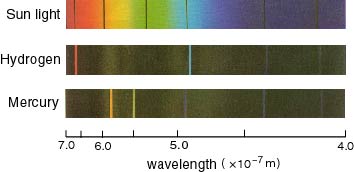Proton-Electron Mass Ratio
 Spectra of Hydrogen and Mercury
Spectra of Hydrogen and MercuryNew measurements of starlights suggest that the ratio of the proton's mass to the electron's mass has increased by 0.002% over 12 billion years. The spectra of hydrogen gas as recorded in lab is compared with spectra of light coming from hydrogen clouds billions of light years away when the universe was in its youth.
Molecular hydrogen absorbs light of specific wavelengths, and the resulting spectrum of "absorption lines" uniquely identifies Hydrogen atom by the 'bar' code made up of such lines. The positions of the lines depend on the ratio of the mass of the proton to the mass of the electron. Of course, one needs to carefully take into account the effect of the expansion of the universe which shifts these lines from higher (ultraviolet) to lower (visible) frequency.
The researchers have reported in Physical Review Letters this week that the mass-ratio of proton and electron (the ratio is about 1836 and is denoted by the letter mu) has increased by about 20 parts per million over the past 12 billion years. The proton-to-electron mass ratio figures in setting the scale of the strong nuclear force.
More studies of spectra of Hydrogen gas from distant galaxies are needed to confirm whether the mass ratio has indeed changed.
Here is the link to the abstract of the paper in Physical Review Letters.

0 Comments:
Post a Comment